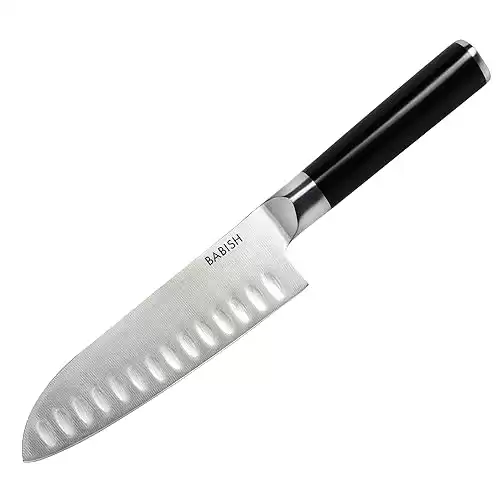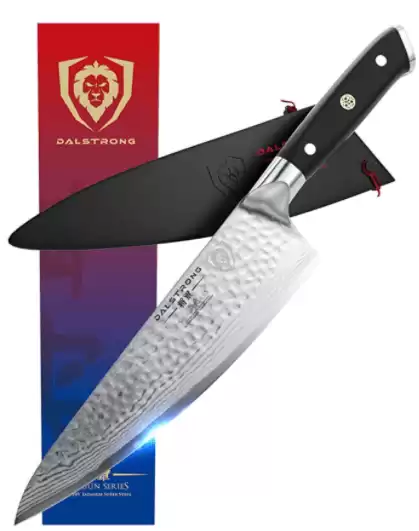This content contains affiliate links. If you make a purchase after clicking a link on this page, we might receive a commission at no cost to you.
The Santoku knife and chef’s knife are both multi-purpose knives used for all things slicing. In some regards, a Santoku knife is very similar to the chef’s knife that you may already have in your knife block.
The Santoku knife vs Chef knife can be similar in purpose and appearance. However, they have different details like knife length, shape, and cutting style.
Both types of knives are used for prepping food, mincing herbs and spices, and cutting up fruits and vegetables. They are great grilling accessories. However, their cutting technique is different, so you want to make sure your knife is living up to its full potential by learning the right techniques for each knife.
High-Level Overview
If you really want to impress your friends and colleagues, you can show off the fact that you know the difference between a Santoku knife and a chef’s knife.
Although incredibly similar, they do have a few differences. Just like the chef’s knife, the Santoku knife is multi-purpose and is useful for everything from mincing vegetables to slicing through meat.
The Santoku blade, however, has a different shape than that of the chef’s knife. It can cut finer slices and can be used to scoop up anything you may have been cutting thanks to its blade shape. Another major difference between these two is that the Santoku knife is crafted specifically in Japan.
Keep reading to learn more about the difference between Santoku knives and chef’s knives.
Blade Shape
The Santoku knife blade is lighter, thinner, and wider than a typical chef’s knife. It has a flatter curve and a pointed tip for more detailed cuts. The scalloped indentations help food release from the blade.
Origins
The Santoku knife was originally crafted in Japan. Its name translates to “three virtues” referring to its uses for meat, fish, and vegetables. The classic chef’s knife has European origins.
Cutting Style
The Santoku knife’s flat blade makes it ideal for straight up-and-down slicing. The typical chef’s knife uses a rocking motion for chopping. The Santoku’s sheepsfoot blade also allows for scooping up food.
Caring For the Knives
Both knives require proper sharpening and hand washing. Santoku knives should be stored in a wooden sheath for protection.
Santoku Knife vs. Chef Knife
Let’s break it down more individually:
Santoku Knife
The word Santoku roughly translates to “three virtues.” Depending on which culinary expert you ask, these three virtues can mean different things. Some believe these virtues refer to the three different parts of the blade – the edge you use for slicing, the heel that you use for cutting intensely, and the tip that is used for a more detailed cut.
Others believe that the three virtues refer to the types of foods that can be cut with this type of knife: it’s essentially a Japanese steak knife but also great for other meats, vegetables, and fish.
Regardless of what you believe about the three virtues, it’s safe to say that the Santoku knife is essential for just about any type of cooking.
- Specially designed by Andrew Rea, creator of Babish Culinary Universe
- Full-tang handle provides a balanced, comfortable grip
Santoku Knife Background
The Santoku Knife is originally from Japan and incorporates a sheep’s foot design that makes it ideal for linear slicing. It is based on a Samurai sword, but created for more practical purposes.
Santoku knives were first introduced in the mid-20th century and were created as an alternative to a vegetable cleaver, otherwise known as a nakiri.
Santoku Characteristics
A Santoku knife can be identified by its shape and size. A Santoku knife is going to be much lighter and smaller than a chef’s knife. The blade is also wider and more flat than that of a chef’s knife while the tip of the knife also has a curve to it.
The Santoku has a scalloped edge that leaves air pockets in the food it cuts to prevent the slices from sticking together. As a result, the Santoku is ideal for slicing herbs, vegetables, fish, and even cheese.
As mentioned earlier, both knives can be used for slicing and cutting things in the kitchen. However, the Santoku knife is used when you need to make a more delicate cut. Don’t underestimate the Santoku knife though, it has a blade that can cut through bone, too.
Caring for A Santoku Knife
The Santoku Knife is easy to care for, it just needs to be sharpened and stored properly. You can do this by hand-washing the knife with dish soap and then storing it in a wooden box.
Chef’s Knife
The chef’s knife is perhaps the most common knife in the kitchen, aside from the steak knife. It can be distinguished via its 8 to 12-inch blade and its prominent curve. The curve is used for performing the “rock chop.”
The tip of the chef’s knife can be used to trim fat on meat, while the heel of the knife is used for thick pieces of meat and fruits like melons.
These knives are pretty common and a staple in almost every kitchen. We’ve written a couple of resources on chef knives – check out our articles on the best chef knife under $100 and best Damascus chef knives to learn more about this classic type of knife.
- 66 layers of high carbon steel
- Triple riveted handle is comfortable during extended use
Other Common Kitchen Knives
Utility knives and paring knives are other kitchen staples. Utility knives handle a variety of tasks like the chef’s knife. Paring knives are great for peeling fruits and vegetables.
The Santoku and chef’s knives may look similar, but differences in blade design make each better suited for certain cutting techniques. Once you understand their specialized uses, you’ll know when to use which knife.
Here are some suggested frequently asked questions that could be added:
Frequently Asked Questions
What is the main difference between a Santoku and a Chef knife?
The main difference is in the blade shape. Santoku knives have a wider, flatter blade optimized for slice cuts. Chef’s knives have a curved blade for rocking chops.
Which is better for chopping vegetables?
Santoku knives are generally considered better for slicing through vegetables because of their straight blade angle. The flat edge makes clean cuts.
Can you use a rocking motion with a Santoku knife?
While Santoku knives are designed for up and down slicing, you can use a rocking motion with the curved tip. It may just take some practice adjusting from a chef’s knife.
What knife is better for meat and fish?
Chef’s knives are ideal for cutting through thick cuts of meat with their heavier blade. But Santoku and chef’s knives both handle fish equally well.
Should I sharpen my Santoku knife differently?
Santoku and chef’s knives can be sharpened using the same techniques. Just follow the angle of the existing blade edge.
Can I use a Santoku knife for everything?
While designed for slicing, a Santoku knife’s versatility lets it work for most kitchen tasks. But for specialized jobs like cutting bread, a serrated knife is best.
Final Thoughts
A Santoku knife and a chef’s knife are both very similar. But if you’ve paid attention, you know there’s more than meets the eye.
At the end of the day, which is best for you comes down to preference and the type of cooking you like to do. And of course, it can’t hurt to have both in your kitchen arsenal!










